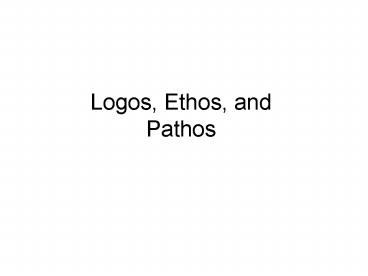Logos, Ethos, and Pathos PowerPoint PPT Presentation
1 / 14
Title: Logos, Ethos, and Pathos
1
Logos, Ethos, and Pathos
2
Argument Claims with Reasons
- Rhetorical Triangle
- Logos - internal consistency and clarity, logic
of reasons and support (logical appeal) - Ethos - credibility of arguer, care in presenting
alternate views, writer investment in claims,
possibly reputation for honesty and expertise
(ethical appeal) - Pathos - appealing to audiences imaginative
sympathies, making argument palpable and
immediate
3
Rhetorical Triangle
Message (LOGOS How can I make the argument
consistent and logical? How can I find the best
reasons and evidence?)
Writer or Speaker (ETHOS How can I present
myself effectively? How can I enhance my
credibility and trustworthiness?)
Audience (PATHOS How can I make the reader open
to my message? How can I appeal to the readers
values and interests?)
4
Facts
- What are they?
- A fact is a noncontroversial piece of data that
is verifiable through observation or through
appeal to communally accepted authorities. - Facts can increase persuasiveness by having
- -Recency. Whats the latest data?
- -Representativeness. Are the supporting exampes
typical rather than extreme or rare. - -Sufficiency. Are there enough examples to
justify the point. (No hasty generalization.)
5
Issue Questions are the Basis of Argument
- Issue question controversial question that gives
rise to alternative answers. - Issue versus information questions
- -Some questions merely call for more information,
not argument. In answering an information
question, you assume the role of a teacher. - -But if you must assume the role of an advocate,
then the question is an issue question. - -Also if the facts of the answer are
controversial, then the question is an issue
question.
6
Arguments Claims Supported by Reasons
- What is a reason?
- A reason is a claim used to support another
claim. - Reasons are usually linked to their claims with
words like because, thus, since, consequently,
and therefore to underscore their logical
connection. - Formulating lists of reasons for the competing
views can break the persuasive task into more
manageable subtasks. - A good way to formulate an argument is to create
a working thesis statement that summarizes your
main reasons as because clauses attached to your
claim. However, be aware of the opposing points
of view.
7
The Idea of Warrants
- Based on the work of philosopher Stephen Toulmin
- Toulmin rejected the model of argument based on
formal logic. - He favored an audience-based courtroom model.
- -All assertions and assumptions are contestable
by opposing counsel - -All final verdicts about the persuasiveness of
an argument are rendered by a neutral third
party, judge, or jury. - The opposing counsel forces us to anticipate
counterarguments and to question our assumptions. - The judge and jury press us to answer opposing
arguments fully and effectively. - The warrant is the unstated assumption upon which
an argument is based and that may have to be
examined itself.
8
Warrants
Evidence
Counter-evidence
Synthesis
Conclusion
9
Logos--Evidence
- Types of evidence
- Evidence from personal experience
- Evidence from interviews, surveys, and
questionnaires - Evidence from written sources
- Evidence from numerical data and statistics
10
Evidence from Personal Experience
- Collected from Memory
- -Anecdotal evidence
- -This can give flavor and specificity to an
argument - -But can personal experience be generalized? Too
narrow? - -To strengthen an argument, the personal
experience should be backed up by broader
evidence (e.g., testimony of experts, accurate
statistics) - Collected from Observations
- -This is the basis of the experimental method.
- -But observations should be carefully made and
unbiased. - -The best observational experiments are carefully
planned and complete for their purposes. Not easy
to do.
11
Evidence from Interviews, Surveys, and
Questionnaires
- Interviews are a good way to collect new
information (things you might not be aware of)
and alternate points of view. - -These can still be narrow may still want other
evidence. - Surveys and questionnaires can be useful if you
can get good response from the community of
interest - -Good questions can be hard to formulate.
12
Evidence from Written Sources
- This is a main way of obtaining broader evidence
to support your arguments. - Reading can supply facts (or purported facts) and
examples (e.g., specific cases) - -Distinguish between indisputable facts and
claims. - Arguments are often buttressed by summaries of
research (with references included). - How will you find expert opinions? And remember
that experts sometimes disagree.
13
Evidence from Numerical Data and Statistics
- Numerical data and statistics have an air of
precision and quantitativeness about them. - But remember that there can be good data and bad
data! - Statistical graphics can be very good in showing
the relationships (that may not be easy to see
otherwise) in a set of data. But the graphics
must be constructed carefully. - -Avoid the USA Today effect (graphics that are
irrelevant or superfluous and just used for color
and snappy design).
14
Get the Most from your Evidence
- When possible, select data from sources that the
reader will trust. - Distinguish fact from inference or opinion
- -Remember that fact is a noncontroversial piece
of data that is verifiable through observation or
throug appeal to communally accepted authorities. - Increase persuasiveness by ensuring
- -Recency. Cite the most recent evidence unless it
is a timeless issue. - -Representativeness. Supporting examples are more
persuasive when the audience believes they are
typical rather than extreme. - -Sufficiency. Beware of making sweeping
generalizations on insufficient evidence.

